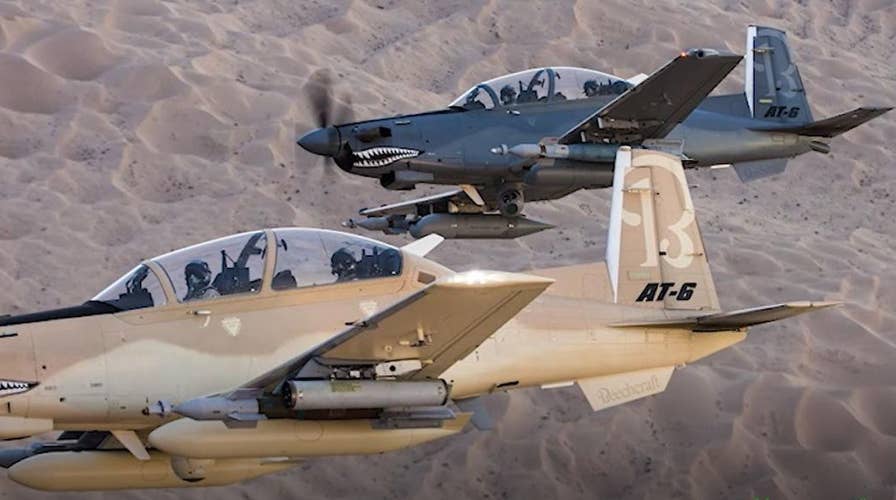AT-6 Wolverine: Inside look at fierce weapons-armed plane
Defense Specialist Allison Barrie shares an insider's look into the AT-6 Wolverine and reveals how this retro-looking hybrid can closely support U.S. troops on the ground by providing a wide variety of firepower from the air
During World War II, Beechcraft supported the war effort by making more than 7,400 airplanes deep in the heartland of America at its factory in Kansas. About 90 percent of the U.S. Army Air Corps bombardiers and navigators were trained on derivatives of the Beechcraft Model 18 - the AT-7 and AT-11 aircraft.
Now the company's latest effort, the AT-6 Wolverine, is poised to join the fight against current enemies of the United States.
Between the paint job and frame, the new jet definitely evokes the style of the iconic fighters from the WWII era, but don’t let those looks fool you — this aircraft is packed with state-of-the-art technology.
MEET THE COMBAT CROP DUSTER, ARMED AND ARMORED TO JOIN THE FIGHT
Fierce fighter chock full of weapons
Similar to its animal namesake, the AT-6 Wolverine may not large in stature, but it brings a whole lot of fight and firepower to take on threats to ground forces.
The AT-6 Wolverine is armed to the teeth with a wide range of weapons. Weapon configurations can be tailored to meet the mission – so users are not restricted to a specific set of weapons.
Some options include the HMP-400 .50-Caliber Guns and AGM-114 Hellfire Laser-Guided Missiles. It can also carry general purpose bombs, such as the 250-pound Mk-81 and 500-pound Mk-82.
The Wolverine can also unleash other 500-pound bombs, including the GBU-12 Paveway II Laser-Guided Bomb and the GBU-49 Enhanced Paveway II GPS/Laser-Guided Bomb. Smaller laser-guided bombs, like the 250-pound GBU-58 Paveway II and GBU-59 Enhanced Paveway II GPS are possibilities as well.
Laser-guided rockets like the APKWS 2.75", TALON 2.75" and GATR 2.75" are an option and Wolverine has even successfully deployed 2.75” laser-guided rockets.
Whether it is taking out a terrorist compound or a single terrorist sniper putting troops at risk – the Wolverine can bring the right weapon for the job.
It is also compatible with Joint Terminal Attack Controller (JTAC) systems for both the U.S. and NATO, which is important to integrate into providing excellent close air support for teams on the ground.
HOW SHARKS CAN HELP THE US MILITARY IN THE FUTURE
Modern cockpit and command
The futuristic-looking CMC Esterline glass digital cockpit is familiar to America’s fighter pilots.
Lockheed Martin’s A-10C Combat Mission System that further enables the pilots to command the aircraft is included, as are a moving map, sensor displays and targeting system all available for pilots to use quickly.
For armed reconnaissance, gathering intelligence and conducting surveillance, there’s an advanced Wescam MX-15Di multi-sensor suite. This equips the aircraft with tools that can deliver critical data like color and IR cameras, laser rangefinder sensor pod as well as laser illuminator and laser designator.
Pilots can also take advantage of the GENTEX Scorpion Helmet-Mounted Cueing System as well as the SparrowHawk HUD with integrated tactical navigation, sensor display, weapons management and weapons delivery modes.
In a big change from WWII planes, U.S. Air Force fighter pilots are both male and female. The Wolverine takes that into consideration and incorporates a Martin Baker Mk-16 ejection seat that suits such a wide range of pilots body sizes, accounting for approximately 95 percent of the current pilot population.
USS GERALD R. FORD: INSIDE THE WORLD'S MOST ADVANCED AIRCRAFT CARRIER
Under consideration by the Air Force
The aircraft is currently participating in the USAF OA-X Experiment that is considering new, smart, lower cost options for light attack and close air support type missions.
It is currently undergoing batteries of testing out at Holloman Air Force Base in New Mexico.
The Wolverine has lots of potential to be used by the military to support troops on the ground by rapidly flying to their assistance and delivering serious firepower from the air.
Excellent, readily available close air support is an essential component to helping keep US ground forces in war zones as safe as possible.
Compared to other turboprop light attack aircraft, the AT-6 Wolverine has one of the highest power to weight ratios thanks to its special engine.
It can reach speeds of about 500 miles per hour, making it one of the speediest light attack turboprops. When ground teams need support, speed is important because a minute can be the difference between life and death.





















